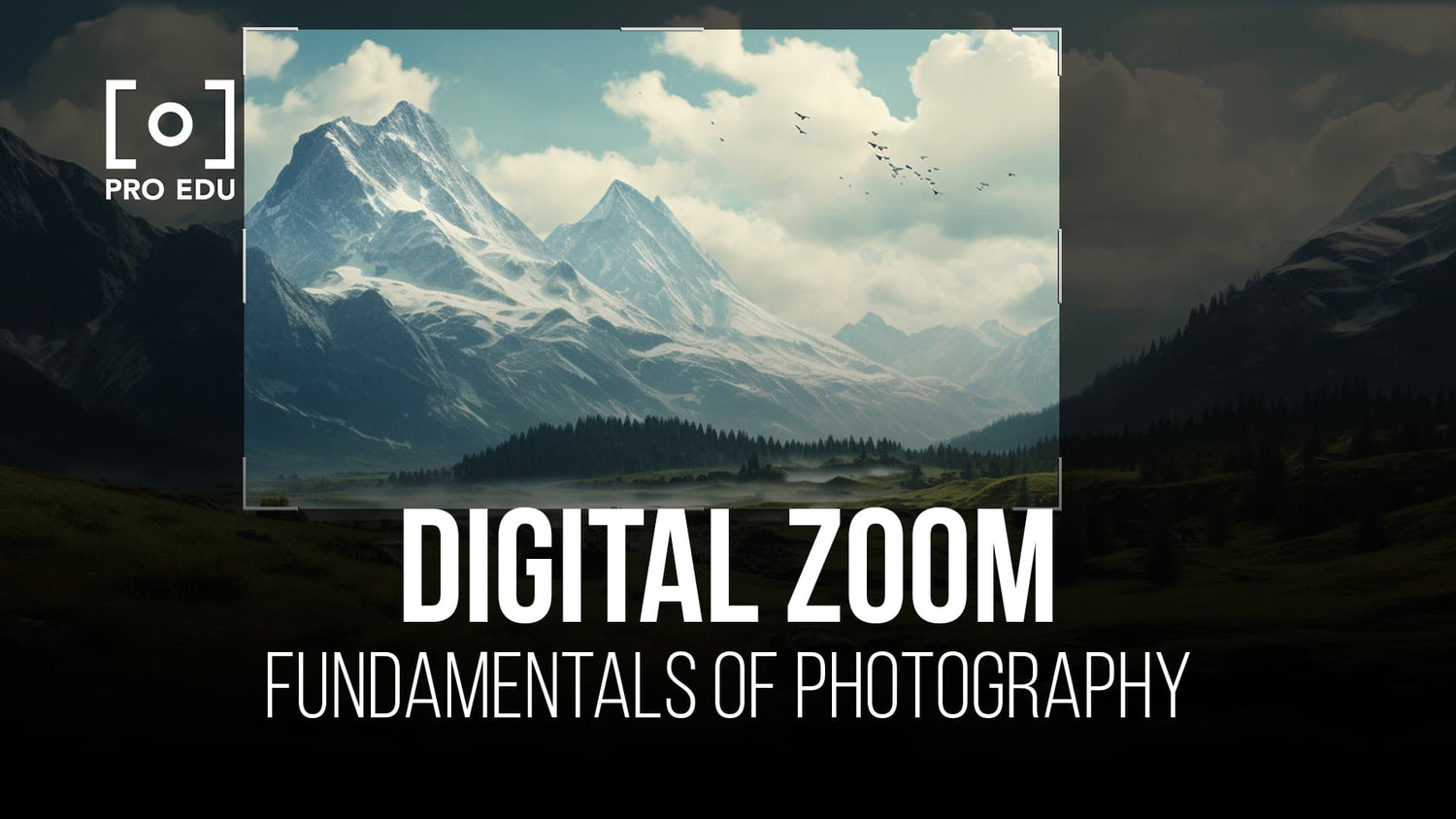Exploring Digital Zoom in Photography: A Quick and Easy Intro
In the world of photography, digital zoom often gets overshadowed by its superior sibling – optical zoom. However, it's essential for beginner photographers to understand the basics of digital zoom and how it can be utilized effectively. Digital zoom is a feature commonly found in cameras, especially compact and smartphone cameras, that enables users to zoom in on their subjects without using optical zoom provided by the camera lens.
The essence of digital zoom is that it selects the center area of the image and magnifies it digitally. This is different from optical zoom, which relies on the physical movement of lens elements to get closer to the subject while retaining image quality. Knowing how digital zoom works and when to use it can greatly impact the success of your photography journey, particularly as you explore various styles and settings.
Key Takeaways
- Digital zoom is a camera feature that magnifies the center area of an image without relying on lens movement.
- Understanding digital zoom is important for beginner photographers looking to explore different photography styles.
- Mastering camera settings like ISO and focal length can enhance your shots when using digital zoom.
Understanding the Basics
When exploring digital zoom in photography as a beginner, it's essential to understand some key terms and concepts related to camera functionality. We'll briefly discuss images, light, sensor, quality, exposure, shutter speed, composition, resolution, mirrorless, and pixels in this section.
Images are created through the interaction of light and a camera's sensor. A sensor is like a digital canvas that captures the light entering the camera through the lens. The quality of an image depends on various factors, such as the sensor's resolution, the camera's settings, and the composition of the subject. Image quality plays a crucial role in the overall appeal of your photographs. Proper exposure is essential as it determines the balance of light and dark areas in an image. Adjusting the shutter speed controls the exposure by changing the duration the sensor is exposed to light.
Composition is the arrangement of elements in your image, and having a strong one can make your photograph visually appealing and engaging. One important aspect to consider in composition is the resolution. High-resolution images contain more pixels, allowing for more detail and better image quality.
Many photographers now opt for mirrorless cameras, which have fewer mechanical parts compared to traditional DSLRs and provide the benefit of a smaller, lighter body. Mirrorless cameras still offer exceptional image quality and can be perfect for beginners exploring digital photography.
In conclusion, understanding these basic principles will help you achieve better results as you explore digital zoom in photography. Happy shooting!
Equipments Essentials
Choosing Your Camera
When starting in photography, it's essential to choose the right camera. DSLRs and mirrorless cameras are popular choices for beginners due to their versatility and ease of use. With a larger sensor, these digital cameras offer better image quality than most smartphones. For example, DSLRs are known for their optical viewfinders, wide selection of lenses, and longer battery life. However, mirrorless cameras are more compact and offer an electronic viewfinder, making them an appealing option for on-the-go photographers.
As a beginner, you may want to start with a simpler, more affordable camera and gradually upgrade as your skills improve. It's essential to consider factors like your budget, the type of photography you want to pursue, and the specific features you need while making your decision.
Understanding Lenses
Lenses play a crucial role in photography, and having a basic understanding of different lens types can help you capture better images. There are three primary types of lenses you may want to consider as a beginner: zoom, telephoto, and prime lenses.
-
Zoom Lens: Zoom lenses offer a range of focal lengths in one lens, allowing you to adjust the level of magnification without changing lenses. They are versatile and ideal for situations where you need some flexibility, such as travel or event photography.
-
Telephoto Lens: Telephoto lenses have longer focal lengths, making them perfect for capturing subjects that are far away, like wildlife or sports photography.
-
Prime Lens: Prime lenses have a fixed focal length, often providing sharper images and better low-light performance. They are ideal for portrait photography and situations where you want a shallow depth of field.
It's vital to explore different lenses based on your specific photography needs. As you gain experience, you can invest in a diverse set of lenses to help you achieve various creative effects and cover a wide range of photography scenarios.
Mastering Camera Settings
The Exposure Triangle
The exposure triangle consists of three essential elements that affect the quality of your photos: ISO, shutter speed, and aperture. Familiarizing yourself with these settings is crucial in taking perfectly exposed images.
ISO controls the camera's sensitivity to light. Lower ISO values (e.g., 100 or 200) are best for well-lit situations, while higher values (e.g., 800 or 1600) are suitable for low-light conditions. However, keep in mind that higher ISOs can cause noise in your images.
Shutter speed determines how long the camera's shutter is open, allowing light to reach the sensor. Faster shutter speeds (e.g., 1/1000s) can freeze motion, while slower speeds (e.g., 1/30s) may create a motion blur effect. Balancing the shutter speed with the lighting conditions is vital.
Aperture refers to the size of the camera's lens opening, affecting the exposure and depth of field. Small aperture values (e.g., f/1.8) produce a shallow depth of field, while larger values (e.g., f/16) create a deeper depth of field. Adjusting the aperture accordingly allows you to control the focus and background sharpness.
Understanding Autofocus
Autofocus (AF) is a critical aspect of capturing sharp, in-focus images. Modern cameras typically have various autofocus modes and settings that help with different shooting scenarios.
Most cameras have two primary autofocus modes: Single AF (SAF) and Continuous AF (CAF). SAF is useful for static subjects, whereas CAF is best for capturing moving subjects, as it tracks their movement.
Additionally, cameras have AF points that help determine which part of the frame to focus on. By selecting a specific AF point or letting the camera choose, you can ensure that your subject is in focus. It's essential to experiment with your camera's autofocus settings to find what works best for your photography style.
Enhancing Your Shots
The Art of Composition
When it comes to photography, one essential aspect is the composition. Utilizing various techniques, we can create more interesting and visually engaging photos. A key factor is lighting, which can dramatically affect the mood and appearance of an image. Paying attention to the depth of field and aperture settings, we can create captivating shots with the right amount of focus and bokeh.
Important composition techniques, such as the rule of thirds and leading lines, should be considered to keep the viewer's eye engaged. Also, taking advantage of the crop factor of your camera can help you achieve unique compositions with more natural zooming effects.
Post-Processing Tips
To enhance our shots even further, post-processing is an invaluable skill to develop. By using editing software like Adobe Lightroom, we can adjust various elements, such as exposure, contrast, and color balance. With attentive editing, even a seemingly ordinary photo can become exceptional.
Additionally, post-processing allows us to use creative techniques, such as retouching and compositing, allowing our images to stand out. When it comes to retouching, less is often more – subtlety is key. Finally, learning about proper export settings and color profiles is crucial for ensuring the final images display correctly across different devices and formats.
Exploring Types of Photography
Landscape and Wildlife Photography
As we dive into photography for beginners, it's essential to explore different types of photography. Landscape photography captures the beauty of nature in its rawest form, showcasing breathtaking scenery and diverse environments. Wildlife photography, on the other hand, focuses on taking pictures of animals in their natural habitats, often requiring patience and the right equipment.
Using a telephoto lens can significantly enhance both landscape and wildlife photography. It allows you to capture distant subjects while maintaining image quality and sharpness. On top of that, having a telephoto lens can create a beautiful bokeh effect by blurring the background, which helps emphasize the main subject in your frame.
Portrait Photography Techniques
Another popular style in photography is portrait photography, which concentrates on capturing people's faces and expressions. It requires different techniques compared to landscape and wildlife photography to achieve the best results. By utilizing a shallow depth of field, we can create a pleasing bokeh effect, making the subject stand out from the background.
We recommend experimenting with different lighting setups and poses to find the most flattering angles for your subject. Additionally, investing in a quality lens with a wide aperture will provide a more professional and appealing look, helping you excel in portrait photography.
In conclusion, understanding the basics of landscape, wildlife, and portrait photography is a great starting point for beginners. Remember, choosing the right equipment, such as a telephoto lens, and mastering various techniques will vastly improve the quality of your images.
Frequently Asked Questions
What are the differences between digital zoom and optical zoom?
Digital zoom works by selecting the middle of the image and zooming in on it through magnification, while optical zoom involves the physical movement of lens elements to zoom in on a subject. Optical zoom generally retains image quality, while digital zoom can sometimes cause a loss in detail and resolution.
How does digital zoom affect image quality?
When using digital zoom, the camera enlarges the image by magnifying the pixels, which can cause a reduction in image quality, often resulting in pixelation. This can be more noticeable when zooming in to higher levels.
What are the pros and cons of using digital zoom in photography?
Digital zoom can be helpful when you need to get closer to a subject without physically moving, but it comes at the cost of image quality. Pros of digital zoom include its availability in most cameras and ease of use. However, the cons comprise reduced image quality, pixelation, and potential loss of resolution.
How can beginners improve their photography skills without relying on digital zoom?
Instead of relying on digital zoom, we recommend learning composition techniques, understanding camera settings, and getting familiar with your gear. Professional photography tutorials can be a valuable resource for developing these skills and improving your overall photography.
When should digital zoom be used in photography?
Ideally, digital zoom should be used sparingly and only when necessary. For example, if you cannot physically get closer to the subject or if your lens lacks the necessary focal length, digital zoom may be a viable temporary solution. However, always consider the impact it may have on image quality.
What are some alternatives to digital zoom for achieving better close-up shots?
Some alternatives to digital zoom include using optical zoom lenses, prime lenses with a longer focal length, or macro lenses for close-range photography. These options will typically provide better image quality and preserve the resolution of your photos.















